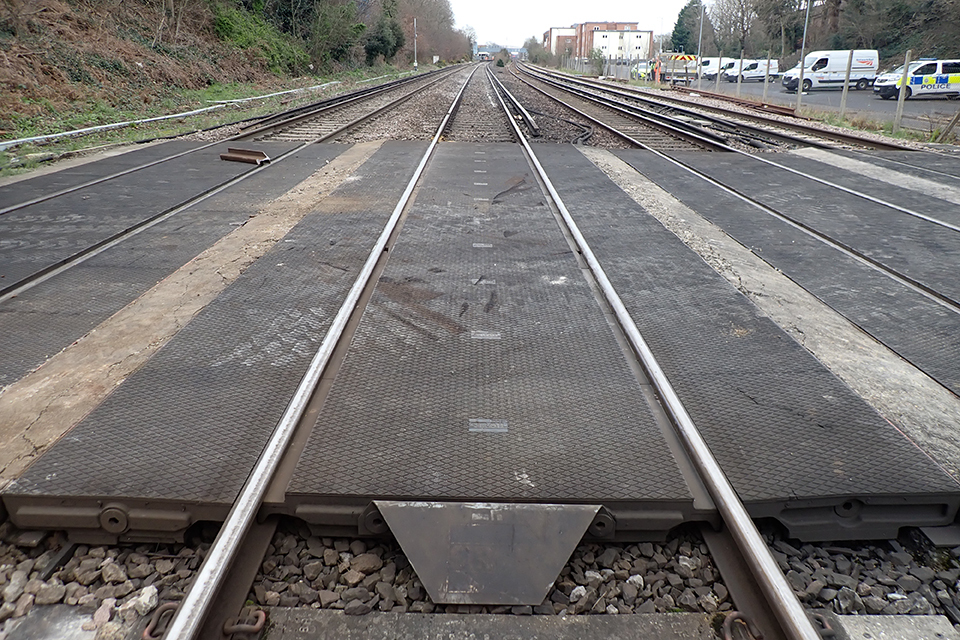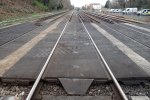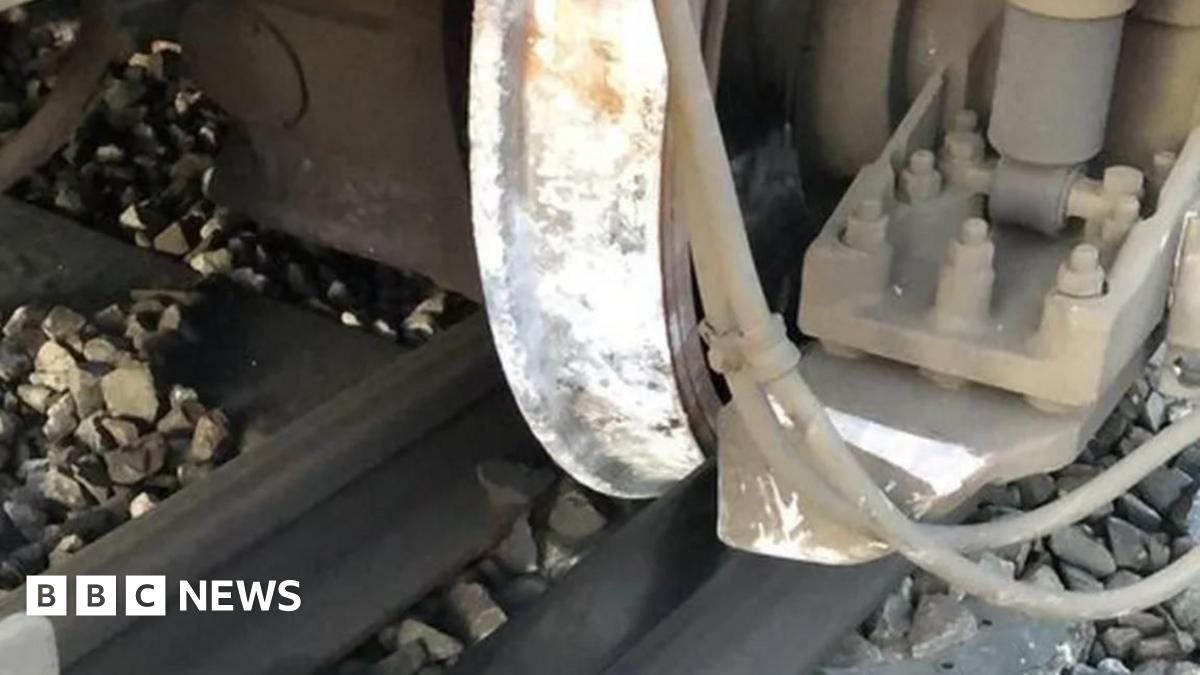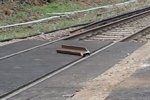Should there be a walk-through of the possession site or a ride through on a small truck (thinking of push-up/ push downs trucks as featured on the St Trinians Great Train Robbery!) at the completion of the works to verify that each track is clear for trains?
-
Our new ticketing site is now live! Using either this or the original site (both powered by TrainSplit) helps support the running of the forum with every ticket purchase! Find out more and ask any questions/give us feedback in this thread!
You are using an out of date browser. It may not display this or other websites correctly.
You should upgrade or use an alternative browser.
You should upgrade or use an alternative browser.
Derailment between Hersham & Walton on Thames (04/03)
- Thread starter TT-ONR-NRN
- Start date
Sponsor Post - registered members do not see these adverts; click here to register, or click here to log in
R
RailUK Forums
Nicholas Lewis
On Moderation
Yes each worksite owner should do that. There is no requirement to check other areas within the possession that never had a worksite other than to remove detonators and stop boards at the limits.Should there be a walk-through of the possession site or a ride through on a small truck (thinking of push-up/ push downs trucks as featured on the St Trinians Great Train Robbery!) at the completion of the works to verify that each track is clear for trains?
The problem here is this could result in a requirement for first train to pass through under caution and probably without passengers if we aren't careful as the trust in people to deliver what is required of them is being lost.
Hellzapoppin
Member
- Joined
- 16 Jan 2016
- Messages
- 252
When I was part of the construction team in NR capital delivery I would always walk through with the Coss to make sure it was safe for the passage of trains before handback. Got a few moans about doing it but it always happened.
I know this starts to sound unreasonable, but possibly so does the first train through after weekend track works tanking through at 90mph in the dark. We can all count up "first train Monday morning" (or at least first after overnight works) incidents, a number mentioned above, even the Clapham accident was the first Monday morning trains running at the shortest headways. Terror of being hit by delay accountants for any time loss passing through at reduced speed seems to exercise minds excessively.The problem here is this could result in a requirement for first train to pass through under caution and probably without passengers if we aren't careful as the trust in people to deliver what is required of them is being lost.
Nicholas Lewis
On Moderation
Its not unreasonable but rather than it being by exception it then gets planned into the timetable is what we know is likely to happen. Its fair point about running at line speed in the dark mind you although even in the light really only 20mph is likely to be the speed that would give a driver sufficient time to stop short of obstruction which give the length of some possessions these days could have quite an impact.I know this starts to sound unreasonable, but possibly so does the first train through after weekend track works tanking through at 90mph in the dark. We can all count up "first train Monday morning" (or at least first after overnight works) incidents, a number mentioned above, even the Clapham accident was the first Monday morning trains running at the shortest headways. Terror of being hit by delay accountants for any time loss passing through at reduced speed seems to exercise minds excessively.
Dozens of trains had passed through Clapham before the accident happened and running through with a train beforehand wouldn't have revealed it.
norbitonflyer
Established Member
Fine until someone leaves the trolley itself on the trackShould there be a walk-through of the possession site or a ride through on a small truck (thinking of push-up/ push downs trucks as featured on the St Trinians Great Train Robbery!) at the completion of the works to verify that each track is clear for trains?
== Doublepost prevention - post automatically merged: ==
Other examples include one on the Wuppertal Schwebebahn (suspended system) when a train derailed after hitting a clamp left on one of the rails and fell into the river below, and the maglev accident at Lathen, also in Germany in 2006, when a demonstration run was allowed to start while a maintenance vehicle was still on the track.I know this starts to sound unreasonable, but possibly so does the first train through after weekend track works tanking through at 90mph in the dark. We can all count up "first train Monday morning" (or at least first after overnight works) incidents, a number mentioned above, even the Clapham accident was the first Monday morning trains running at the shortest headways. Terror of being hit by delay accountants for any time loss passing through at reduced speed seems to exercise minds excessively.
Last edited:
Deepgreen
Established Member
Yes, but that wasn't a track work issue (i.e. with identifiable physical obstructions), it was signalling.Its not unreasonable but rather than it being by exception it then gets planned into the timetable is what we know is likely to happen. Its fair point about running at line speed in the dark mind you although even in the light really only 20mph is likely to be the speed that would give a driver sufficient time to stop short of obstruction which give the length of some possessions these days could have quite an impact.
Dozens of trains had passed through Clapham before the accident happened and running through with a train beforehand wouldn't have revealed it.
== Doublepost prevention - post automatically merged: ==
Yes, but the shocker here is that it was at the worksite access point - the most obvious and easiest place to check - rather than half a mile down the line.Should there be a walk-through of the possession site or a ride through on a small truck (thinking of push-up/ push downs trucks as featured on the St Trinians Great Train Robbery!) at the completion of the works to verify that each track is clear for trains?
LambicHedgehog
Member
The RAIB have announced they are investigating this incident.

 www.gov.uk
www.gov.uk
== Doublepost prevention - post automatically merged: ==
They have also posted a larger version of the picture in that link on X (Twitter)


[Withdrawn] Derailment of a passenger train near Walton-on-Thames
Investigation into the derailment of a passenger train following a collision with redundant rail near Walton-on-Thames, Surrey, 4 March 2024.
== Doublepost prevention - post automatically merged: ==
They have also posted a larger version of the picture in that link on X (Twitter)

Last edited:
kingqueen
Member
Nicholas Lewis
On Moderation
Indeed and when you look at time the train on the Up Slow that reported a large bang c30m before the Up Fast train arrived was potentially that piece of rail being knocked from the US to the UF and then back to the US where it could easily impacted the next train on the US.Zoomed in. OMG.
Anyhow good to see RAIB doing an investigation so in due course we understand what happened and depending on recommendations NR will have to respond with what they are doing about it.
The RAIB have announced they are investigating this incident.
And on that note this is where we bring the thread to a close for the time being. As soon as the RAIB have issued a report (interim or otherwise) we will look to reopen the thread.
thanks everyone
The RAIB have now issued their report into this accident and the summary is below:

 www.gov.uk
www.gov.uk
Summary
At around 05:40 on Monday 4 March 2024, a passenger train struck a section of redundant rail that had been left foul of the track on the approach to Walton-on- Thames station. At the time of the collision with this rail, the train was travelling at around 85 mph (137 km/h). The front coach derailed, and the train came to a stand around 500 metres beyond the point of derailment.
The redundant rail had inadvertently been left there by a team that had completed work in the area over the previous weekend. Checks undertaken after the work was completed did not identify that a section of redundant rail was in a potentially hazardous position before the railway was handed back for normal operation. This was because no person in charge had supervised the work and because a track handback engineer had not been effectively briefed as to what work had been undertaken before they inspected the track.
RAIB found that the arrangements in place for planning and delivering the work did not effectively manage the risk of a section of rail being left foul of the running line and that the process for inspecting the railway after the work was completed did not provide staff with clear guidance on which areas should be checked. Additionally, the relevant railway rules and standards do not clearly define the roles and responsibilities required to safely deliver work on complex work sites like the one involved in the accident.
Recommendations
As a result of its investigation, RAIB has made two recommendations. The first is addressed to Colas Rail (in consultation with Network Rail), to review its processes related to collecting redundant material when working on or near the line. The second is addressed to Network Rail (in consultation with the Rail Safety and Standards Board) to review the rules and standards relating to how tasks delivered in complex work sites should be co ordinated and supervised and to create a coherent process for confirming that the line is safe for the passage of trains after the work is complete.
Additionally, two learning points have been identified. The first reinforces the importance of infrastructure maintainers arranging adequate site lighting. The second concerns the importance of railway organisations ensuring that guidance material relating to superseded standards is removed from resource libraries when new standards are issued.
Statement from Andrew Hall, Chief Inspector of Rail Accidents:
"Following a passenger train striking redundant rail on the track in 2018, RAIB issued Urgent Safety Advice to Network Rail regarding safety of the line after engineering work. Since this advice was issued, RAIB has examined a number of further accidents caused by objects, including temporary road-rail access points and a trolley, being left on the track after the completion of maintenance work. These accidents caused damage to the railway infrastructure, the trains involved and resulted in temporary closures to the affected lines. This most recent accident at Walton-on-Thames resulted in a passenger train derailing at speed. Although no one was hurt on this occasion, the train could easily have deviated from the line of the track and struck other trains or objects.
Maintenance work is often carried out at night which makes ensuring the line is subsequently safe for the passage of trains particularly challenging. The risk is very clear. Unfortunately, this accident happened because that risk was not effectively managed. This, following other similar recent incidents, should serve as a stark reminder of the importance of effectively managing the risk of objects being left on the track after overnight maintenance."

Report 04/2025: Derailment of a passenger train near Walton-on-Thames
Derailment of a passenger train near Walton-on-Thames, surrey, 4 March 2024.
Deepgreen
Established Member
Thanks.The RAIB have now issued their report into this accident and the summary is below:

Report 04/2025: Derailment of a passenger train near Walton-on-Thames
Derailment of a passenger train near Walton-on-Thames, surrey, 4 March 2024.www.gov.uk
Interesting to note that the rail was not spotted because it was not communicated what work had been undertaken. Does this imply that the geographical extent was not clear, I wonder?
This is key, I think, because ANY rail in a dangerous position should have been flagged up if the full extent of the work site was checked.
Given that the default option for redundant rail appears to be to leave it on site, I'm surprised this doesn't happen more often, especially as short sections like the one involved here might be (wrongly) regarded as relatively harmless when left on site.
I still find it amazingly fortunate that this did not become a major disaster, given the speed involved.
Had there been any obstructions (bridge supports, pointwork, etc.) there it would have been horribly different.
== Doublepost prevention - post automatically merged: ==
I note that a BBC News story calls it "Untidy Track" - true, but not helpful to the layman. The story also calls it a 2.5m piece of abandoned railway"! It is 'rail' and the pictures on this thread (posts 218 and 219) show it to be more like 1m long.

Train derailment in Surrey caused by poor management, report said
The train was carrying 100 passengers when it derailed in March 2024 following maintenance work.
www.bbc.co.uk
A train carrying 100 passengers derailed because a track had not been properly cleared following maintenance work, a report has revealed.
The South Western Railway (SWR) train collided with a 2.5m piece of abandoned railway which was left too close to the tracks on the approach to Walton-on-Thames.
The train derailed at about 05:40 GMT on 4 March while travelling at about 85mph (137km/h), according to the Rail Accident Investigation Branch (RAIB). No one was injured.
Last edited:
Nicholas Lewis
On Moderation
So yet again despite the ever increasing level of procedures and standards that have been added that govern doing engineering work on the infrastructure, oh and not forgetting the increasing number of competent roles that have been added, something like this happens.
RAIB provide this image Fig 13 on page 29

that looks around 6ft+ long although report doesn't say exactly. So quite how this can be missed by all these competent people on site is beyond me. The RAIB report feels like its scrabbling around trying to find a cause without looking at the bleeding obvious of how can a lump of rail this size not have been seen by anybody. To my mind they should have also looked at the way the industry is organised with multiple sub contractors and a lack of ownership. Contractors are needed but letting them mark their own homework needs to be reassessed.
This was another lucky escape fortunately here the track ahead was plain line but had there been S&C in its path of a bridge girder the outcome could have been quite different.
RAIB provide this image Fig 13 on page 29

that looks around 6ft+ long although report doesn't say exactly. So quite how this can be missed by all these competent people on site is beyond me. The RAIB report feels like its scrabbling around trying to find a cause without looking at the bleeding obvious of how can a lump of rail this size not have been seen by anybody. To my mind they should have also looked at the way the industry is organised with multiple sub contractors and a lack of ownership. Contractors are needed but letting them mark their own homework needs to be reassessed.
This was another lucky escape fortunately here the track ahead was plain line but had there been S&C in its path of a bridge girder the outcome could have been quite different.
There's always that balancing act of how many Responsible People you have (distinct from people who generally act responsibly...)
One Responsible Person is a single point of failure, and can overlook an issue with no formal check and balance.
Too many Responsible People, and you have a whole network of people that overlook an issue because they all think that everyone else was responsible to check that item.
There is a sweet spot, but I don't know where.
That report makes the organisation structure at a site like that seems big and overly complicated (from an outsider's POV)
One Responsible Person is a single point of failure, and can overlook an issue with no formal check and balance.
Too many Responsible People, and you have a whole network of people that overlook an issue because they all think that everyone else was responsible to check that item.
There is a sweet spot, but I don't know where.
That report makes the organisation structure at a site like that seems big and overly complicated (from an outsider's POV)
notverydeep
Member
- Joined
- 9 Feb 2014
- Messages
- 1,080
The RAIB report feels like it’s scrabbling around trying to find a cause without looking at the bleeding obvious of how can a lump of rail this size not have been seen by anybody.
This is addressed and generates one of the ‘Learning Points’ rather than recommendations. It wasn’t seen because (having presumably been dropped there by the Road Rail Vehicle while unloading several other such pieces of rail), it was a dark object against a dark background during the night in an area where no lights were set up. It thus implies that those unloading the rails didn’t see that one of the many they were handling had been overlooked.
The fact that this first crew had not spotted the rail could then have been caught by those checking the work site, but they did not check the particular area directly because they were unaware that work had occurred there and again did not notice it from where they did check because it was dark.
Therefore a Learning Point was included to remind work planners to make sure adequate lighting was available for all areas of work. This was not a recommendation, because this is already a clear requirement of the standards for planning such work.
Last edited:
Nicholas Lewis
On Moderation
RRVs have very good lights on them projecting in all directions with high lux levels to illuminate the area. Then at the RRAP we have machine operator (Quattro) who was accompanied by a machine controller (Dynamic) along with a team leader running the site (Ash) and im surmising some additional operatives. Then someone else nominated as PIC (Colas) along with there handback engineer (Colas) and an ES (Cleshar) and no doubt the PICOP was out sourced as well.This is addressed and generates one of the ‘Learning Points’ rather than recommendations. It wasn’t seen because (having presumably been dropped there by the Road Rail Vehicle while unloading several other such pieces of rail), it was a dark object against a dark background during the night in an area where no lights were set up. It thus implies that those unloading the rails didn’t see that one of the many they were handling had been overlooked.
In my experience the handback/trackback engineer primary role is to determine if the track is fit for the opening linespeed as they need to consider a variety of technical information from the tamper or site surveys as well as a visual view of the site. They would then get others to sign off the sheet for the various other items of work that had been undertaken and those nominated individuals would have been responsible for there area of work. All RRAP points used were part of the inspection as there is also a risk of the panels becoming dislodged when you have heavy RRVs manoeuvring on them.The fact that this first crew had not spotted the rail could then have been caught by those checking the work site, but they did not check the particular area directly because they were unaware that work had occurred there and again did not notice it from where they did check because it was dark.
So the underlying issue is really a non compliance with existing standards and I suppose we should be grateful that RAIB didn't at least suggest adding even more complication to the industry and creating another competency. They or perhaps the ORR should be looking deeper at the culture in the industry that is created by this multitude of sub contracting weekend warriors.Therefore a Learning Point was included to remind work planners to make sure adequate lighting was available for all areas of work. This was not a recommendation, because this is already a clear requirement of the standards for planning such work.
Not sure if this has already been mentioned upthread, but the first train to hit the said piece of rail, 2F02 04.30 Woking to Waterloo, is shown on the https://timetables.trainsplit.com site as having arrived at Surbiton 12 minutes early at 04.41 rather than the booked arrival time of 04.53 in which case it must only have taken 11 minutes to get from Woking to Surbiton. It was ten minutes late leaving Surbiton at 05.06 against the booked departure time of 04.56, though, and it was 17 minutes late into Waterloo at 05.36 instead of 05.19. I understand that it was a Class 444.
PyrahnaRanger
Member
There is a body of psychological study on just that subject, kick started by Stanley Milgram (infamous for the "electric shock" memory tests).There's always that balancing act of how many Responsible People you have (distinct from people who generally act responsibly...)
One Responsible Person is a single point of failure, and can overlook an issue with no formal check and balance.
Too many Responsible People, and you have a whole network of people that overlook an issue because they all think that everyone else was responsible to check that item.
There is a sweet spot, but I don't know where.
That report makes the organisation structure at a site like that seems big and overly complicated (from an outsider's POV)
He was more interested in how large groups have to be before inaction becomes commonplace, and found once you get more to than ~20 people, they will ignore some terrible things as they assume someone else will sort it out. That work on the bystander effect did lead on to other work looking at smaller groups as well, so there's probably something in there too.
Actually, there may be a bit of Asch's conformity theory going as well - they've all said it's OK, and I trust them, so I must be mistaken...
I reckon I could get a decent dissertation out of this - anyone fancy letting me shadow some contractors?

